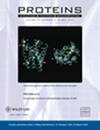Dynamically driven correlations in elastic net models reveal sequence of events and causality in proteins
IF 3.2
4区 生物学
Q2 BIOCHEMISTRY & MOLECULAR BIOLOGY
引用次数: 0
Abstract
An explicit analytic solution is given for the Langevin equation applied to the Gaussian Network Model of a protein subjected to both a random and a deterministic periodic force. Synchronous and asynchronous components of time correlation functions are derived and an expression for phase differences in the time correlations of residue pairs is obtained. The synchronous component enables the determination of dynamic communities within the protein structure. The asynchronous component reveals causality, where the time correlation function between residues弹性网模型中的动态相关性揭示了蛋白质中的事件序列和因果关系
对于受到随机和确定性周期力作用的蛋白质的高斯网络模型,给出了朗格文方程的显式解析解。推导出了时间相关函数的同步和非同步分量,并得到了残基对时间相关性的相位差表达式。通过同步分量可以确定蛋白质结构中的动态群落。异步分量揭示了因果关系,残基 i 和 j 之间的时间相关函数因 i 是在 j 之前还是相反而不同,从而产生定向信息流。通过扰动扫描技术确定了环纤蛋白 A 和人类 NAD 依赖性异柠檬酸脱氢酶异生过程中的驱动和被驱动残基。确定了影响残基波动相位差的因素,如网络拓扑结构、连通性和残基中心性。在各向同性高斯网络模型的限制下,我们的研究结果表明,异步性会随着残基间粘度和距离的增加而增加,随着连通性的增加而减少,随着特征向量中心性水平的增加而降低。
本文章由计算机程序翻译,如有差异,请以英文原文为准。
求助全文
约1分钟内获得全文
求助全文
来源期刊

Proteins-Structure Function and Bioinformatics
生物-生化与分子生物学
CiteScore
5.90
自引率
3.40%
发文量
172
审稿时长
3 months
期刊介绍:
PROTEINS : Structure, Function, and Bioinformatics publishes original reports of significant experimental and analytic research in all areas of protein research: structure, function, computation, genetics, and design. The journal encourages reports that present new experimental or computational approaches for interpreting and understanding data from biophysical chemistry, structural studies of proteins and macromolecular assemblies, alterations of protein structure and function engineered through techniques of molecular biology and genetics, functional analyses under physiologic conditions, as well as the interactions of proteins with receptors, nucleic acids, or other specific ligands or substrates. Research in protein and peptide biochemistry directed toward synthesizing or characterizing molecules that simulate aspects of the activity of proteins, or that act as inhibitors of protein function, is also within the scope of PROTEINS. In addition to full-length reports, short communications (usually not more than 4 printed pages) and prediction reports are welcome. Reviews are typically by invitation; authors are encouraged to submit proposed topics for consideration.
 求助内容:
求助内容: 应助结果提醒方式:
应助结果提醒方式:


